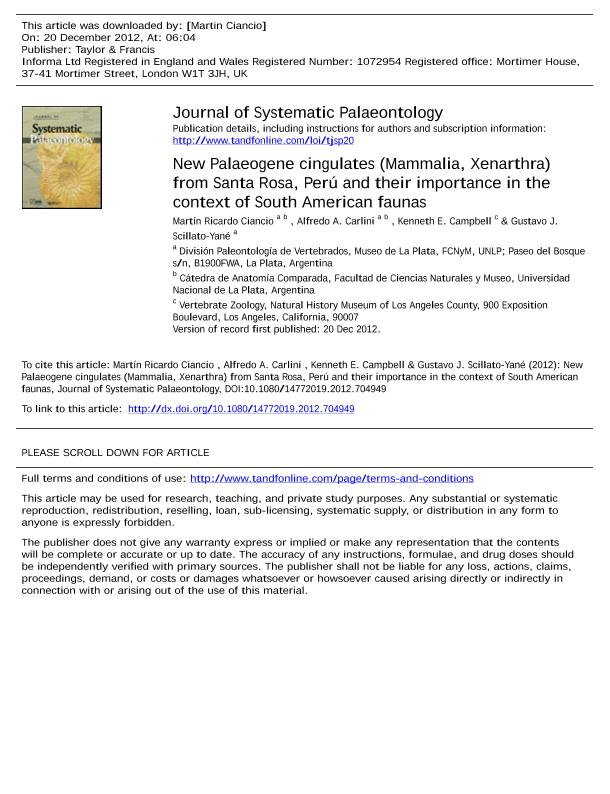Mostrar el registro sencillo del ítem
dc.contributor.author
Ciancio, Martin Ricardo

dc.contributor.author
Carlini, Alfredo Armando

dc.contributor.author
Campbell, Kenneth E.
dc.contributor.author
Scillato, Gustavo Juan

dc.date.available
2017-08-30T11:50:36Z
dc.date.issued
2012-12
dc.identifier.citation
Ciancio, Martin Ricardo; Carlini, Alfredo Armando; Campbell, Kenneth E.; Scillato, Gustavo Juan; New Palaeogene cingulates (Mammalia, Xenarthra) from Santa Rosa, Perú and their importance in the context of South American faunas; Taylor & Francis; Journal of Systematic Palaeontology; 11; 6; 12-2012; 727-741
dc.identifier.issn
1477-2019
dc.identifier.uri
http://hdl.handle.net/11336/23283
dc.description.abstract
The record of Palaeogene cingulate xenarthrans in low latitudes 33 is very poor. 34 In this sense, the cingulate fauna from the Yurúa River near Santa Rosa in eastern Perú is 35 important because it is one of the oldest known from the Palaeogene from Perú and 36 because of its tropical latitudinal position. Although remains are scarce, we recognize 37 three new taxa: two species of Astegotheriinae (Dasypodidae); Parastegosimpsonia 38 peruana nov. gen. et sp., of small size, related to Eocene species from Patagonia, and 39 another new species, ?Parastegosimpsonia, which consists of an incomplete osteoderm 40 representing the largest species of this tribe. A third species, Yuruatherium tropicalis nov. 41 gen. et sp., of indeterminate suprageneric rank, shares features with Machlydotherium 42 Ameghino (Casamayoran-Tinguirirican SALMA ?middle Eocene-early Oligocene of 43 Patagonia) and is similar to Eocoleophorus Oliveira et al. (Deseadan SALMA ?late 44 Oligocene of Brazil). Also we assign to Yuruatherium nov. gen. the species 45 ?Machlydotherium intortum (from the late Eocene of Patagonia). Sediments bearing 46 these cingulates also yielded rodents, marsupials, and notoungulates, among the most 47 frequent mammals. The absolute age of the sediments is unknown, but an estimated age 48 is inferred from the studies of mammalian assemblages. Even so the age of the Santa 49 Rosa local fauna is still controversial and, given the groups taken into account, could be 50 from early Eocene to late Oligocene. According to sequences of southern cingulate 51 faunas (especially those of Dasypodidae), the cingulates from Santa Rosa also suggest an 52 age between the late Eocene to early Oligocene for the fauna. Nevertheless, the very low 53 latitude of Santa Rosa local fauna should be taken into account because in lower latitudes 54 it is not uncommon to find taxa with a more generalized set of characters than those 55 displayed by taxa of contemporary levels in higher latitudes.
dc.format
application/pdf
dc.language.iso
eng
dc.publisher
Taylor & Francis

dc.rights
info:eu-repo/semantics/openAccess
dc.rights.uri
https://creativecommons.org/licenses/by-nc-sa/2.5/ar/
dc.subject
AMAZONIA
dc.subject
ASTEGOTHERIINI
dc.subject
CINGULATA
dc.subject
DIVERSITY
dc.subject
LOW LATITUDES
dc.subject
PALAEOGENE
dc.subject
PERÚ
dc.subject.classification
Oceanografía, Hidrología, Recursos Hídricos

dc.subject.classification
Ciencias de la Tierra y relacionadas con el Medio Ambiente

dc.subject.classification
CIENCIAS NATURALES Y EXACTAS

dc.title
New Palaeogene cingulates (Mammalia, Xenarthra) from Santa Rosa, Perú and their importance in the context of South American faunas
dc.type
info:eu-repo/semantics/article
dc.type
info:ar-repo/semantics/artículo
dc.type
info:eu-repo/semantics/publishedVersion
dc.date.updated
2017-08-28T14:30:21Z
dc.journal.volume
11
dc.journal.number
6
dc.journal.pagination
727-741
dc.journal.pais
Reino Unido

dc.journal.ciudad
Londres
dc.description.fil
Fil: Ciancio, Martin Ricardo. Universidad Nacional de la Plata. Facultad de Ciencias Naturales y Museo. División Paleontología Vertebrados; Argentina. Consejo Nacional de Investigaciones Científicas y Técnicas; Argentina. Universidad Nacional de la Plata. Facultad de Ciencias Naturales y Museo. Laboratorio de Anatomia Comparada; Argentina
dc.description.fil
Fil: Carlini, Alfredo Armando. Universidad Nacional de la Plata. Facultad de Ciencias Naturales y Museo. División Paleontología Vertebrados; Argentina. Consejo Nacional de Investigaciones Científicas y Técnicas; Argentina. Universidad Nacional de la Plata. Facultad de Ciencias Naturales y Museo. Laboratorio de Anatomia Comparada; Argentina
dc.description.fil
Fil: Campbell, Kenneth E.. Natural History Museum of Los Angeles County; Estados Unidos
dc.description.fil
Fil: Scillato, Gustavo Juan. Universidad Nacional de la Plata. Facultad de Ciencias Naturales y Museo. División Paleontología Vertebrados; Argentina. Consejo Nacional de Investigaciones Científicas y Técnicas; Argentina
dc.journal.title
Journal of Systematic Palaeontology

dc.relation.alternativeid
info:eu-repo/semantics/altIdentifier/doi/http://dx.doi.org/10.1080/14772019.2012.704949
dc.relation.alternativeid
info:eu-repo/semantics/altIdentifier/url/http://www.tandfonline.com/doi/abs/10.1080/14772019.2012.704949
Archivos asociados
